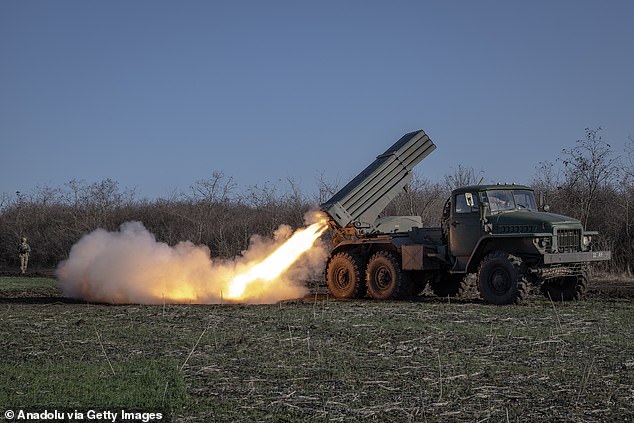Inside Biden’s deal with Ukraine that ties the US for 10 years and gives Zelensky a $50billion loan
A new deal, backed by up to $50 billion in U.S. loan guarantees, will shore up Ukraine’s defenses for a long war against Russia and signal to Vladimir Putin that allies are committed to the long term, despite battlefield gains. said President Biden.
The package, agreed in principle but with key details still missing, will show that allies are not “backing down,” Biden said in Italy on Thursday.
The White House is touting the deal as a central achievement of the G7 summit, where allies moved forward on the complex financing plan even as Biden and Ukrainian President Volodymyr Zelensky signed a separate deal committing the U.S. to 10 years of security assistance.
The plan, which has been in the works for years, is based on about $300 billion in seized Russian assets, much of which is held in European banks. Not all coalition members agreed to spend the assets immediately, prompting policymakers to negotiate ways to leverage the huge interest.
But even Biden isn’t proclaiming a completely done deal. He said G7 leaders “signed a plan to finalize and release proceeds.” His aides also declined to specify exactly how much the U.S. would borrow, how many allies would step in and even which allies were involved.
A French official said earlier this week that U.S. funds would be “replenished” by European allies, indicating an uncertain level of financial commitment.
The idea is to ‘put that money to work for Ukraine.’ Biden called it “another reminder to Putin: We don’t give up.” In fact, we stand together against this illegal aggression.”
He spoke about the agreement at a news conference with Zelensky, where a large sign announced a separate security agreement they had signed.
The White House is touting a 10-year deal that would allow the US to provide security assistance to Ukraine. But it is an “executive agreement” that the administration admits does not need to remain in place if Biden is succeeded by another president.
On a call with reporters Thursday, a senior administration official could not say exactly how many allies would contribute, and in what amounts.
According to the administration, the US is expected to provide the lion’s share of loan guarantees, based on existing lending authority.
“This will be a loan syndicate,” said a senior government official.
‘How are we going to pay it back? Russia pays. ‘The principle is unaffected.’
The idea is to ‘manage’ risk among allies by linking it to a revenue stream of interest – although that won’t stop Russia from coming back at some point to try to claim it.
“Think of it as a secured loan,” the official said. Iran is one of the countries that does indicted at the UN to attempt to recover seized assets and accrued interest.
But there was no definitive top song. “The United States will not be the only lender in this syndicate.” He said the total amount generated by the US “will certainly be just under $50 billion.
Biden, meanwhile, praised the one-for-one deal with Ukraine at his Thursday evening press conference.
At the event, a large sign read: “UNITED STATES-UKRAINE BILATERAL SECURITY AGREEMENT,” and Biden snapped at a reporter who instead asked an off-topic question about Gaza.

A 10-year agreement commits the US to supporting Ukrainian security. But the government admits it is only an “executive agreement.”
The agreement, which the two men signed at the start of the event, commits the US to supporting the country for years to come – although as a non-treaty it would not bind a future US administration. Nevertheless, it is a policy that could put pressure on Donald Trump to stay the course if he were to defeat Biden and regain the White House. (Trump has said he would end the war in one day if elected, without saying how).
A senior administration official defended the deal on Friday when asked specifically whether it would remain in place if there were “another president” – meaning Trump.
‘This is an implementation agreement. It is intended to demonstrate the United States’ steadfast support for Ukraine over the ten-year period. So it is structured in such a way that it has both short-term goals in terms of training and equipment, but also in terms of support for institutional reforms,” the official said.
“We certainly intend to deliver on what is included in this agreement, because it is in the interest of the United States to support Ukraine’s democratic trajectory to support its economic reforms and reconstruction, but also to protect its sovereignty and defend territorial integrity. That is the purpose of the agreement, but as far as you are concerned it is an executive agreement between the United States and Ukraine.”
Zelensky himself said the agreement “contains a very detailed, legally binding part, and this means the credibility of American support for our Ukrainian independence.”
According to a White House faction, the agreement commits to “building and sustaining Ukraine’s credible defense and deterrence capabilities” and “setting out a vision for a Ukrainian future military force that is strong, sustainable and resilient.”
It would “strengthen Ukraine’s ability to sustain its long-term fight, including by building on efforts to strengthen Ukraine’s defense industrial base and support economic recovery and energy security.”
It would also accelerate Ukraine’s integration with Europe by “implementing reforms in its democratic, economic and security institutions, in line with Ukraine’s objectives for EU accession and NATO’s reform programme.” And it calls for the achievement of a “just peace that respects Ukraine’s rights under international law, is supported by broad global support, upholds the key principles of the UN Charter, including sovereignty and territorial integrity, and includes responsibility for Russia’s actions.’
